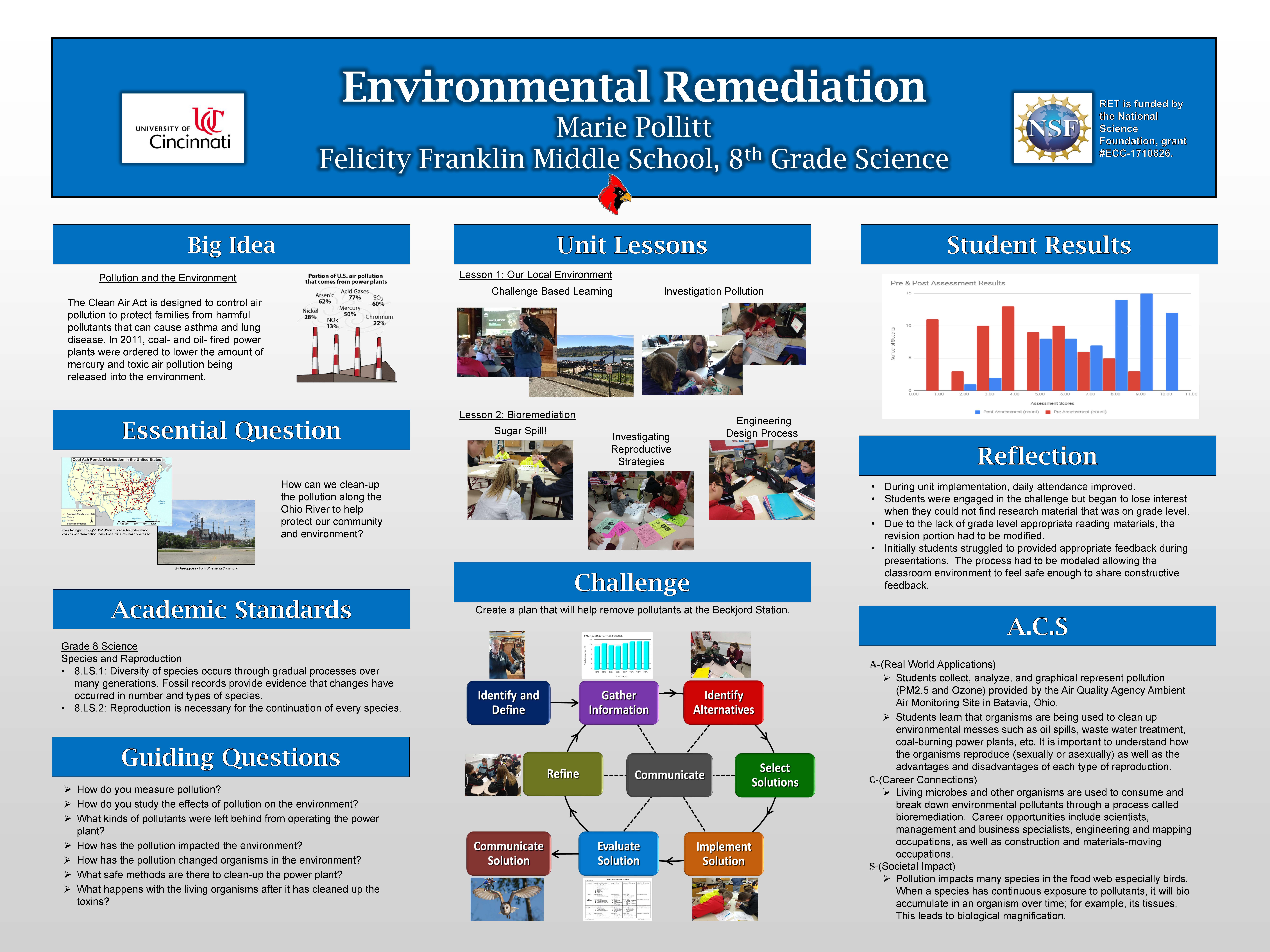Research Experience for Teachers (2018-2019)
Environmental Remediation
 |
||||||
|
||||||
Keywords:
|
|
The Big Idea (including global relevance) Pollution and the Environment: Pollution negatively affects humans, animals, plants, and ecosystems. There are many causes of environmental pollution such as industry, transportation, agriculture activity, trading activity, and residences. Although there are many environmental regulations, toxins are released into the environment at an abundant rate; for example, the W.C. Beckjord Station and its 10 billion pounds of coal ash ponds. These unlined ponds are located along the banks of the Ohio River and contain arsenic, mercury, sulfuric acid, lead, and many other toxins. |
|
Essential Questions
|
|
The Hook
|
|
The Challenge Students will design a plan to safely clean up the ash ponds at Beckjord. |
|
Guiding Questions
|
ACS (Real world applications; career connections; societal impact)
Students collect, analyze, and graphical represent pollution (PM2.5 and Ozone) provided by the Air Quality Agency Ambient Air Monitoring Site in Batavia, Ohio. Students learn that organisms are being used to clean up environmental messes such as oil spills, wastewater treatment, coal-burning power plants, etc. It is important to understand how the organisms reproduce (sexually or asexually) as well as the advantages and disadvantages of each type of reproduction.
Pollution impacts many species in the food web especially birds. When a species has continuous exposure to pollutants, it will bioaccumulate in an organism over time; for example, its tissues. This leads to biological magnification.
- An extensive list of careers in environmental remediation can be found at https://www.bls.gov/green/environmental_remediation/remediation.htm
- During the Communicate Solution (Part 2), students create a PowerPoint to present or defend their solution. Students are required to include careers in environmental remediation. They will research one field from the list below and provide specifics for the careers in that area. A bulletin board will be created to display each of the careers as well as the training needed, salary, etc.
- scientists : biochemists & biophysicists, chemists, chemical technicians, conservations scientists, environmental scientists & specialists, hydrologists, microbiologists
- management & business specialists : compliance officers, construction managers, cost estimators, emergency management directors, natural sciences managers, public relations
- engineering & mapping occupations: cartographers & photogrammetrists, chemical engineers, environmental engineers, environmental engineering technicians, health and safety engineers, mining and geological engineers
- construction & material- moving occupations: construction laborers, dredge operators, earth drillers, excavating and loading machines and dragline operators, hazardous materials removal workers, operating engineers and other construction operators
Misconceptions
- Evolution of Life, states many students believe that environmental conditions are responsible for changes in traits or that organisms develop new traits because they need them to survive.
- Heredity, highlights that students think sexual reproduction results in traits being inherited from only one parent (e.g., the mother or same-sex parent). They also may believe that there is a “blending of characteristics” in offspring.
Unit Lessons and Activities
- Lesson 1: Our Local Environment - Students will develop a common essential questions when given a big idea and hook. They were create a challenge as well as guiding questions that will aide in solving it. Students will investigate the impact water pollution has on all levels of the food chain as well as the consequences of invasive species in an environment. Students collect, analyze, and graphical represent pollution (PM2.5 and Ozone) provided by the Air Quality Agency Ambient Air Monitoring Site in Batavia, Ohio.
- Activity 1: Challenge Based Learning (2 days with 70 minute classes)
- Activity 2: Investigating Pollution (2 days with 70 minute classes)
- Lesson 2: Bioremediation - Students will conduct an experiment using a live microorganism to clean up a pollution. Students work in pairs to compare five aspects of an organism that reproduces sexually with one that reproduces asexually. As a class, students share their comparisons and generate a list of general characteristics for each mode of reproduction, and discuss the advantages and disadvantages of both. They will use the information gathered from the investigations to solve the challenge.
- Activity 3: Sugar Spill! Bioremediation Cleanup Experiment (1.5-2 days with 70 minute classes)
- Activity 4: Investigating Reproductive Strategies (2 days with 70 minute classes)
- Activity 5: Engineering Design Process (EDP) (4-5 days with 70 minute classes)
- Evidence of CBL: Lesson 1, Activity 1
- Evidence of EDP: Lesson 2, Activity 5
Additional Resources
- Big Decisions Loom for Toxic Ponds on Ohio River
https://www.youtube.com/watch?v=VZ9fHY5i4ss
- Report: Hamilton County Among Most Polluted in U.S.
http://www.fox19.com/story/31939819/report-hamilton-county-among-most-polluted-in-us
- Coal and Air Pollution
https://www.ucsusa.org/clean-energy/coal-and-other-fossil-fuels/coal-air-pollution#.WyfBj-4vypo
- Living Lands & Waters
http://livinglandsandwaters.org/education/llws-hands-on-lab-activities/
- Bureau of Labor Statistics
https://www.bls.gov/green/environmental_remediation/remediation.htm
- Investigating Reproductive Strategies
http://teach.genetics.utah.edu/content/evolution/files/ReproductiveStrategies.pdf
- Southwest Ohio Air Quality Agency
http://www.southwestohioair.org/
- Teach Engineering
https://www.teachengineering.org/activities/view/cub_lifescience_lesson04_activity1
